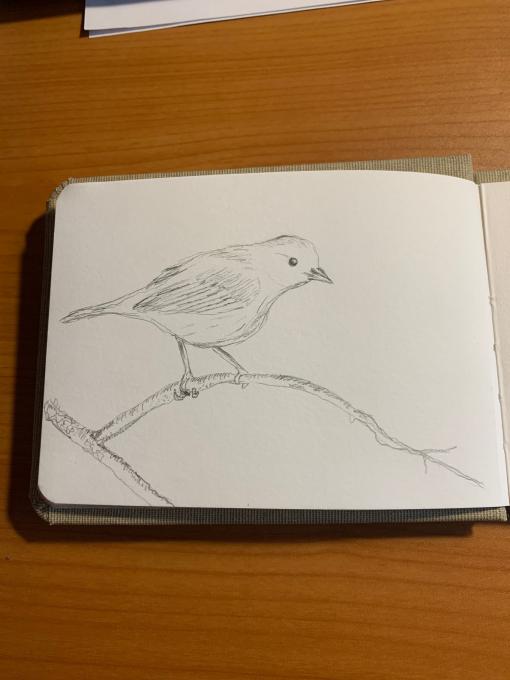The Cornell Lab Bird Academy › Discussion Groups › Nature Journaling and Field Sketching › Jump Right in!
-

-
I enjoyed sketching this way. It felt freeing. The wing bar
-
1. I wasn't familiar with the paints or paintbrush, I kept struggling trying to find a comfortable way to hold the paint box. I knew the proportions weren't quite right and that kept distracting me. My bird looks more like a chicken, somehow. 2. There were lots of things I noticed once I started to pay attention: the way the wing feathers had layers, the different colors of the streaks. This is one of the big advantages of drawing -- you have to really observe.

-
 Drawing is not my strength. Trying to capture the spirit of the bird was what I was hoping for and I saw that many here were able to do that with posture and shape. I tried colour but painting is not my strength either. I will keep experimenting and hopefully improve as we go on. I have seen many of these warblers in the wild and I have always been struck by their bright yellow and in the males a noticeable chestnut streaky breast. These are beautiful birds to appreciate and ID as they migrate through in the spring and trying to capture the essence of one has made me appreciate it even more.
Drawing is not my strength. Trying to capture the spirit of the bird was what I was hoping for and I saw that many here were able to do that with posture and shape. I tried colour but painting is not my strength either. I will keep experimenting and hopefully improve as we go on. I have seen many of these warblers in the wild and I have always been struck by their bright yellow and in the males a noticeable chestnut streaky breast. These are beautiful birds to appreciate and ID as they migrate through in the spring and trying to capture the essence of one has made me appreciate it even more. -

-
Drawing from a photo is easier than trying to do a live bird; I can study it often and return to finish it when I can see if I missed a detail. I noticed the empty spaces around the bird remembering Liz's Saturday afternoon Zoom class that I took. I wouldn't have paid attention to the space around the warbler, if not drawing it. The space around the main focus will help me with the proportions of the nature scene, such as the size of legs compared to the body or size of the head versus the body.
-

-
 Drawing slowed me down and allowed me to really see the breast markings and the shape of the birds beak. I even took time to identify that this is the male of the species. Drawing is like meditation when I'm in the flow. Had to quiet unhelpful self talk first.
Drawing slowed me down and allowed me to really see the breast markings and the shape of the birds beak. I even took time to identify that this is the male of the species. Drawing is like meditation when I'm in the flow. Had to quiet unhelpful self talk first.
-
1. It was more difficult than I thought it would be. It was challenging just to get the shape. I erased many times. 2. There were details and subtleties that I probably would not have noticed if I was not drawing the bird. This would make a considerable difference when nature journaling. I can understand why each person journaling was making notes about the pictures as they were working.
-

-
 Very good to jump in but it was realy challenging.Advantage for drawing: I get more understanding how the bird looks like. For me ist is difficult to match the right colours. To take a good photo is not so easy , too ;).
How did you feel about drawing from the photo? Drawing from a photo is much easier than to do directly in nature
Very good to jump in but it was realy challenging.Advantage for drawing: I get more understanding how the bird looks like. For me ist is difficult to match the right colours. To take a good photo is not so easy , too ;).
How did you feel about drawing from the photo? Drawing from a photo is much easier than to do directly in nature
-
![IMG_20201217_130127567~2[1]](data:image/gif;base64,R0lGODlhAQABAAAAACH5BAEKAAEALAAAAAABAAEAAAICTAEAOw==)
-
 What I liked about this was studying the details. Frustrating to not really be able to judge scale. Benefits of sketching is the attention you pay to the details, a photograph captures the details, but one may not really notice them since everything blends together more. I would not have noticed the veins in the leaves, or the layers of feathers if I didn't draw this and just snapped a photo.
What I liked about this was studying the details. Frustrating to not really be able to judge scale. Benefits of sketching is the attention you pay to the details, a photograph captures the details, but one may not really notice them since everything blends together more. I would not have noticed the veins in the leaves, or the layers of feathers if I didn't draw this and just snapped a photo. -
 Drawing from a photo is easier than a live subject as you can study details. Just admiring a photo, I probably would have missed the lichen on the branches.
Drawing from a photo is easier than a live subject as you can study details. Just admiring a photo, I probably would have missed the lichen on the branches. -
 Photos capture detail that is difficult to achieve with a sketch, particularly from a live bird that is moving around.
Photos capture detail that is difficult to achieve with a sketch, particularly from a live bird that is moving around. -
1. How did you feel about drawing from the photo? What came easily and what was challenging? The hardest was not judging myself--I'm gonna need to practice drawing without self-judgment! The eye and beak came sort of easily, the proportions of the head and body were challenging. So were the lichens--yikes. Oops. Judging again. 2. Was there anything in the photo that you might not have noticed if you weren’t asked to draw it? Would this make a difference when nature journaling? Lots: the texture of the branch, the number of colors in what I thought was simply a yellow bird. I've seen them in the wild but never had a chance to study what they actually look like in detail. Will absolutely make a difference going forward!

-
 - drawing the branches and leaves seemed easier than drawing the warbler
- the warbler's proportions seem off, elongated in my drawing while it seems more compact in the photo
- fun exercise, glad to start on this course!
- drawing the branches and leaves seemed easier than drawing the warbler
- the warbler's proportions seem off, elongated in my drawing while it seems more compact in the photo
- fun exercise, glad to start on this course!
-
 Drawing at all is a challenge after not doing it in so long. Drawing from the photo was helpful because, of course, the bird is not moving, in contrast to the birds at my feeder, who dart in and out, especially the nuthatches, or the birds in the woods, who are seldom close or still. The photo made it possible to really look carefully. I can see the different parts of the wings, but I really don't know how they all fit together. This helps me identify the knowledge I need. I think if I understand and draw the structure of the wing, that will help drawing in the field -- even quick sketches. I actually loved drawing the leaves and the lichen. My frequent "interactions" with leaves and lichens probably inform my drawing.
Drawing at all is a challenge after not doing it in so long. Drawing from the photo was helpful because, of course, the bird is not moving, in contrast to the birds at my feeder, who dart in and out, especially the nuthatches, or the birds in the woods, who are seldom close or still. The photo made it possible to really look carefully. I can see the different parts of the wings, but I really don't know how they all fit together. This helps me identify the knowledge I need. I think if I understand and draw the structure of the wing, that will help drawing in the field -- even quick sketches. I actually loved drawing the leaves and the lichen. My frequent "interactions" with leaves and lichens probably inform my drawing. -

-

-
It was a challenge to get the angle of the head and body, my leaves are much smaller then they should be. If this was in nature I would not of had any chance to study it, getting the color of the Warbler or the gray on the branch or the lichens on the branch. I normally take photo's of birds, getting the light correct and getting a good pose, you have to be fast and take a lot of photo's as they jump around from branch to branch.
-
-
How did you feel about drawing from the photo? It was a challenge which is why we are taking the course and are using it to connect with a granddaughter many miles away over Zoom. What came easily and what was challenging? The eye and beak were the easiest and the body was the hardest. Was there anything in the photo that you might not have noticed if you weren’t asked to draw it? The angle of the legs seemed unnatural so I was drawn to the fact that I had to correct my first attempt which was straight up and down. I also "felt" right away that something was off in my picture even though I thought "that can't be right" when looking at the angle of the legs at first so it kept me honest! Would this make a difference when nature journaling? It would depend on time and purpose. In a photo you might be able to go back and notice a detail but in sketching you are more focused at the time so you may note or make note of, some detail you might even miss in the photo.

-

-

-
 1. Very good, it was very good to jump directly to illustrate, I wanted to do it in a more detailed way similarly, detailing from the branches to the bird itself.
2.Maybe you see the details of the moss on the branches. This could make a difference because it could give us data on the type of vegetation and even the climate, in this case, for example, the moss on the branches denotes that it was a humid environment.
1. Very good, it was very good to jump directly to illustrate, I wanted to do it in a more detailed way similarly, detailing from the branches to the bird itself.
2.Maybe you see the details of the moss on the branches. This could make a difference because it could give us data on the type of vegetation and even the climate, in this case, for example, the moss on the branches denotes that it was a humid environment. -
I love drawing from photos because you have time to really study every aspect - the light brown in the feathers, the pattern of black in the wings...Drawing from nature wont allow the luxury of unhurried study

-
I love how you got the little nod of its head. Not sure what you did to do so? Bill profile definitely, but still, I can't see what you did beyond that (and bill profile is subtle!) Also love the shading you did on the head and back. Branch detail is great too! Joan
-
Read More:
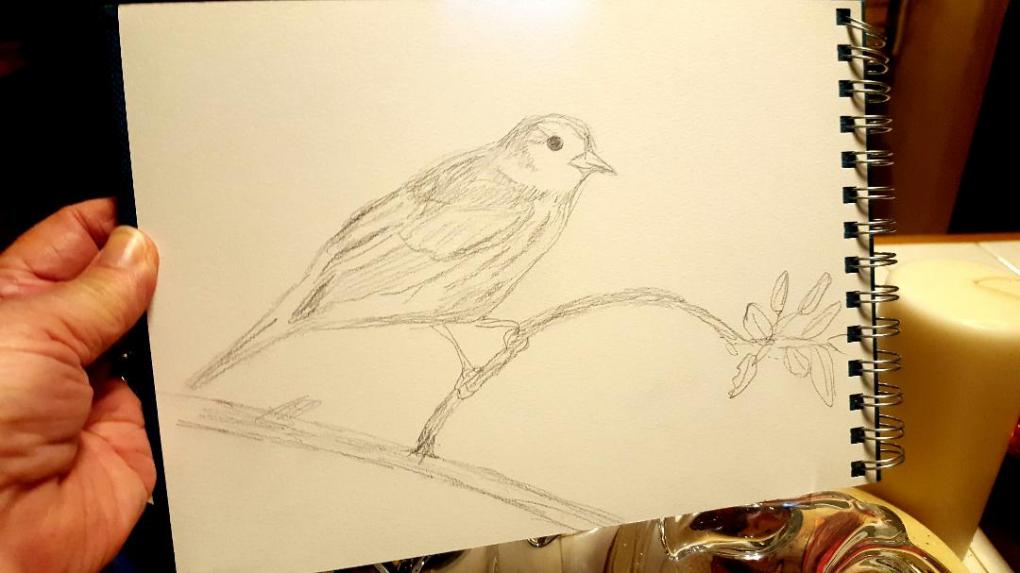
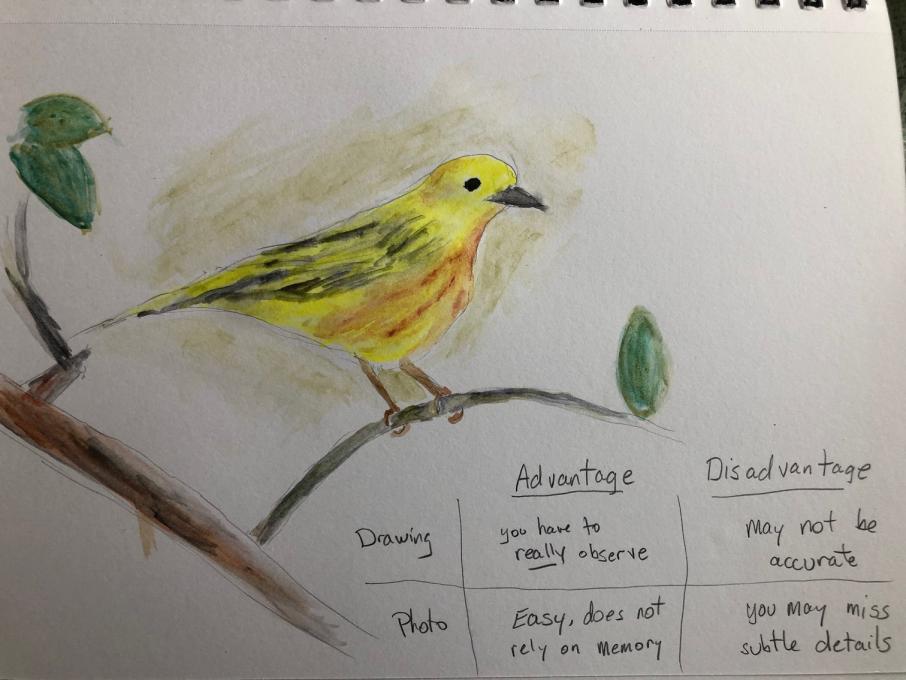
 Drawing is not my strength. Trying to capture the spirit of the bird was what I was hoping for and I saw that many here were able to do that with posture and shape. I tried colour but painting is not my strength either. I will keep experimenting and hopefully improve as we go on. I have seen many of these warblers in the wild and I have always been struck by their bright yellow and in the males a noticeable chestnut streaky breast. These are beautiful birds to appreciate and ID as they migrate through in the spring and trying to capture the essence of one has made me appreciate it even more.
Drawing is not my strength. Trying to capture the spirit of the bird was what I was hoping for and I saw that many here were able to do that with posture and shape. I tried colour but painting is not my strength either. I will keep experimenting and hopefully improve as we go on. I have seen many of these warblers in the wild and I have always been struck by their bright yellow and in the males a noticeable chestnut streaky breast. These are beautiful birds to appreciate and ID as they migrate through in the spring and trying to capture the essence of one has made me appreciate it even more. 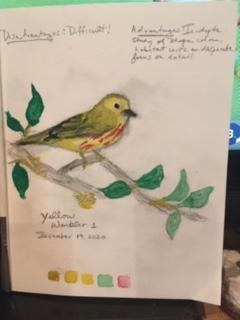
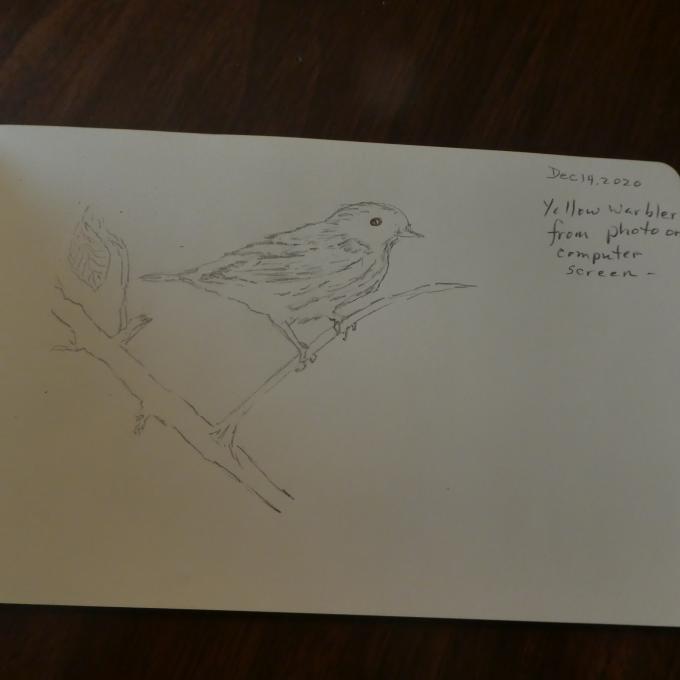
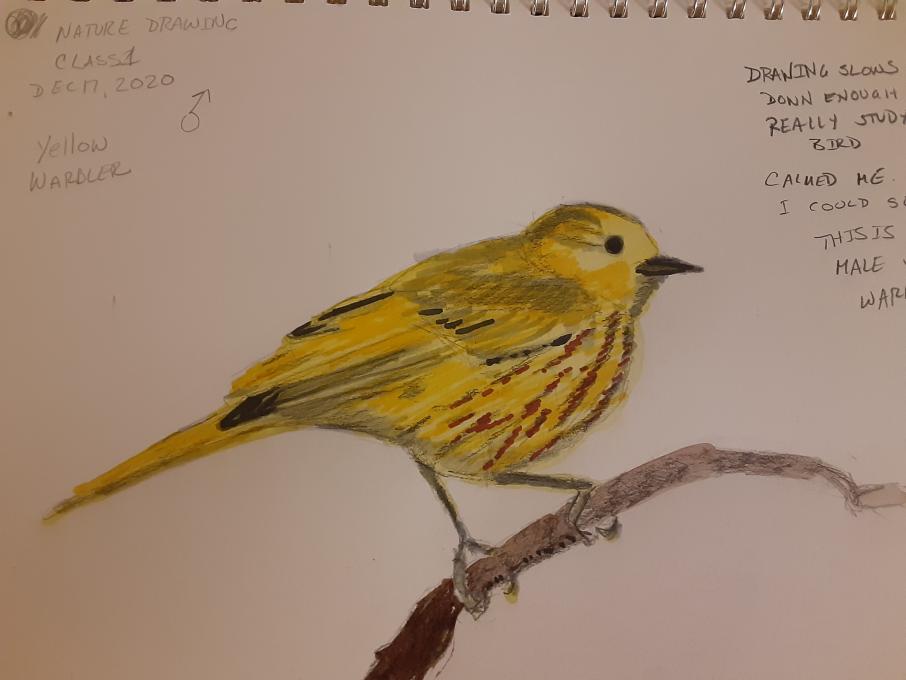 Drawing slowed me down and allowed me to really see the breast markings and the shape of the birds beak. I even took time to identify that this is the male of the species. Drawing is like meditation when I'm in the flow. Had to quiet unhelpful self talk first.
Drawing slowed me down and allowed me to really see the breast markings and the shape of the birds beak. I even took time to identify that this is the male of the species. Drawing is like meditation when I'm in the flow. Had to quiet unhelpful self talk first.
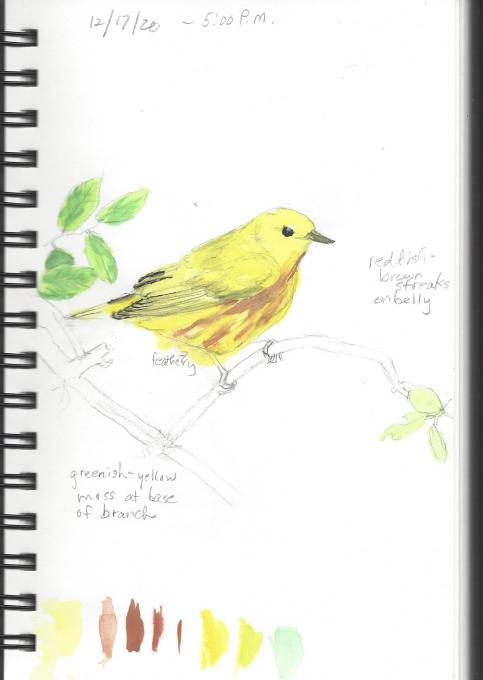
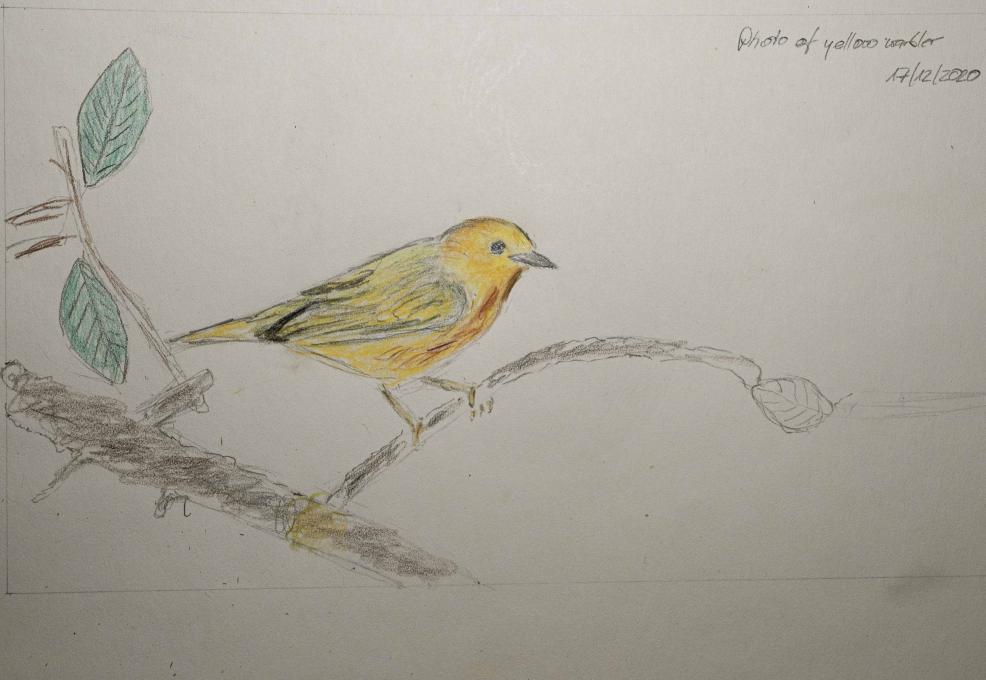 Very good to jump in but it was realy challenging.Advantage for drawing: I get more understanding how the bird looks like. For me ist is difficult to match the right colours. To take a good photo is not so easy , too ;).
How did you feel about drawing from the photo? Drawing from a photo is much easier than to do directly in nature
Very good to jump in but it was realy challenging.Advantage for drawing: I get more understanding how the bird looks like. For me ist is difficult to match the right colours. To take a good photo is not so easy , too ;).
How did you feel about drawing from the photo? Drawing from a photo is much easier than to do directly in nature
![IMG_20201217_130127567~2[1]](https://academy.allaboutbirds.org/wp-content/uploads/hm_bbpui/761922/Tsnugdl83p5vbs6rwai80xoy63eazhhqd.jpg)
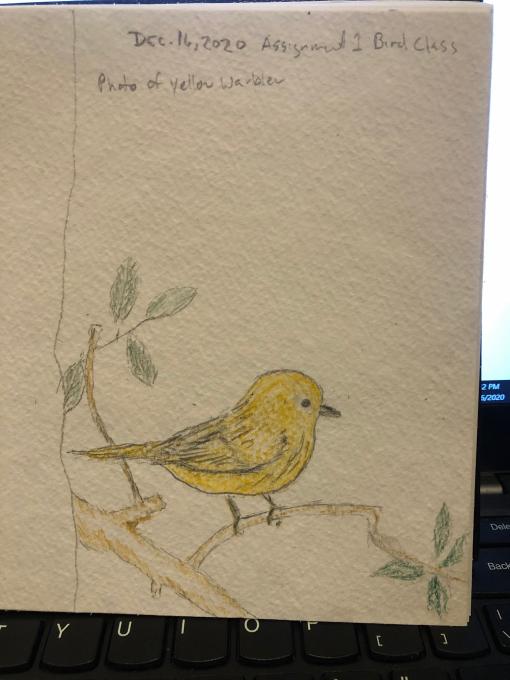 What I liked about this was studying the details. Frustrating to not really be able to judge scale. Benefits of sketching is the attention you pay to the details, a photograph captures the details, but one may not really notice them since everything blends together more. I would not have noticed the veins in the leaves, or the layers of feathers if I didn't draw this and just snapped a photo.
What I liked about this was studying the details. Frustrating to not really be able to judge scale. Benefits of sketching is the attention you pay to the details, a photograph captures the details, but one may not really notice them since everything blends together more. I would not have noticed the veins in the leaves, or the layers of feathers if I didn't draw this and just snapped a photo. 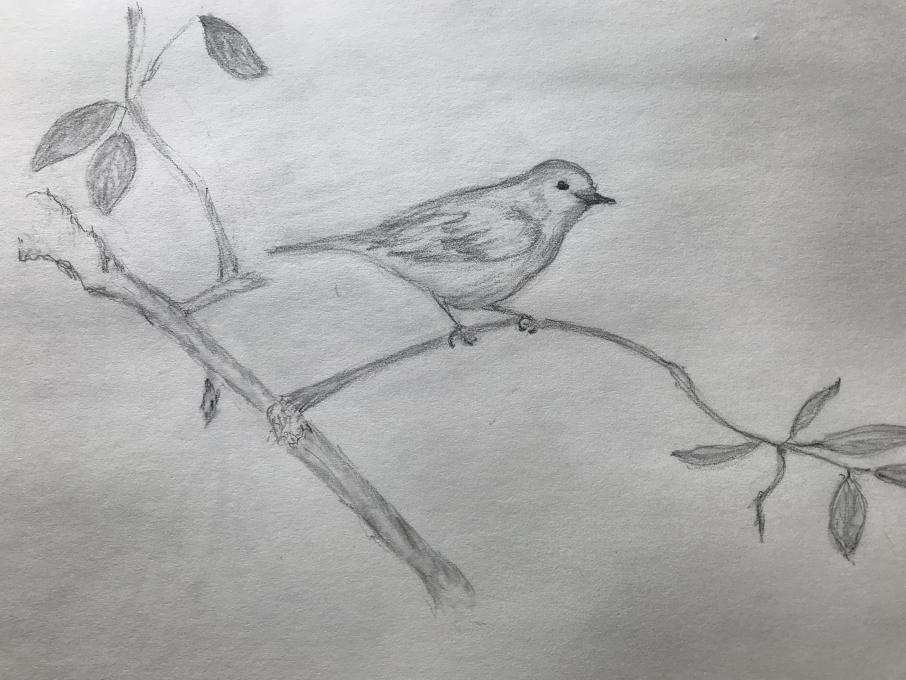 Drawing from a photo is easier than a live subject as you can study details. Just admiring a photo, I probably would have missed the lichen on the branches.
Drawing from a photo is easier than a live subject as you can study details. Just admiring a photo, I probably would have missed the lichen on the branches. 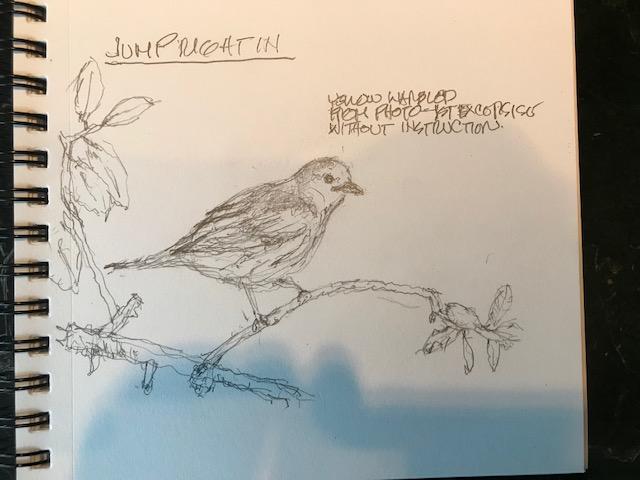 Photos capture detail that is difficult to achieve with a sketch, particularly from a live bird that is moving around.
Photos capture detail that is difficult to achieve with a sketch, particularly from a live bird that is moving around. 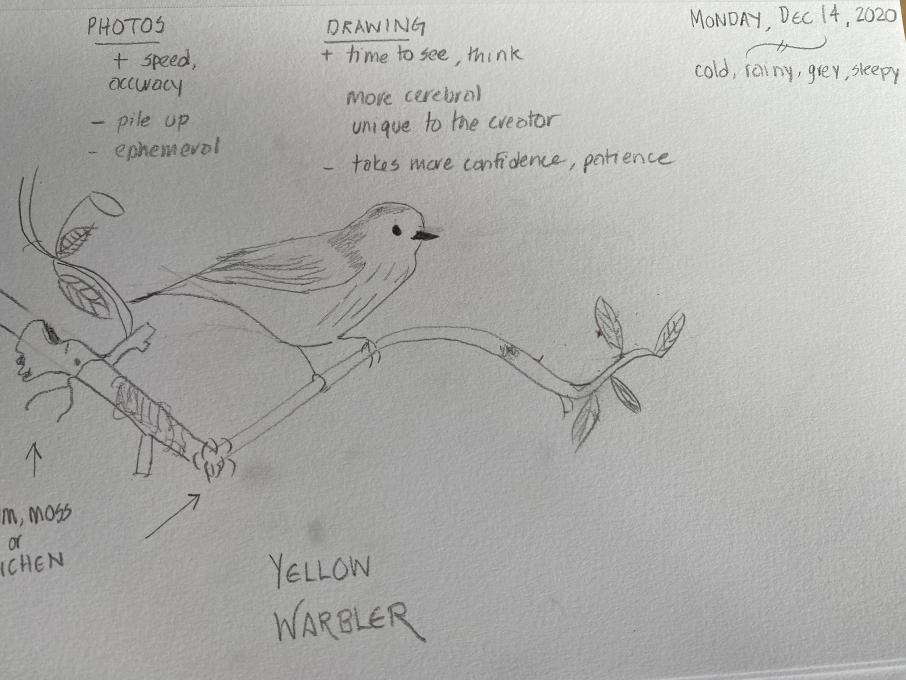
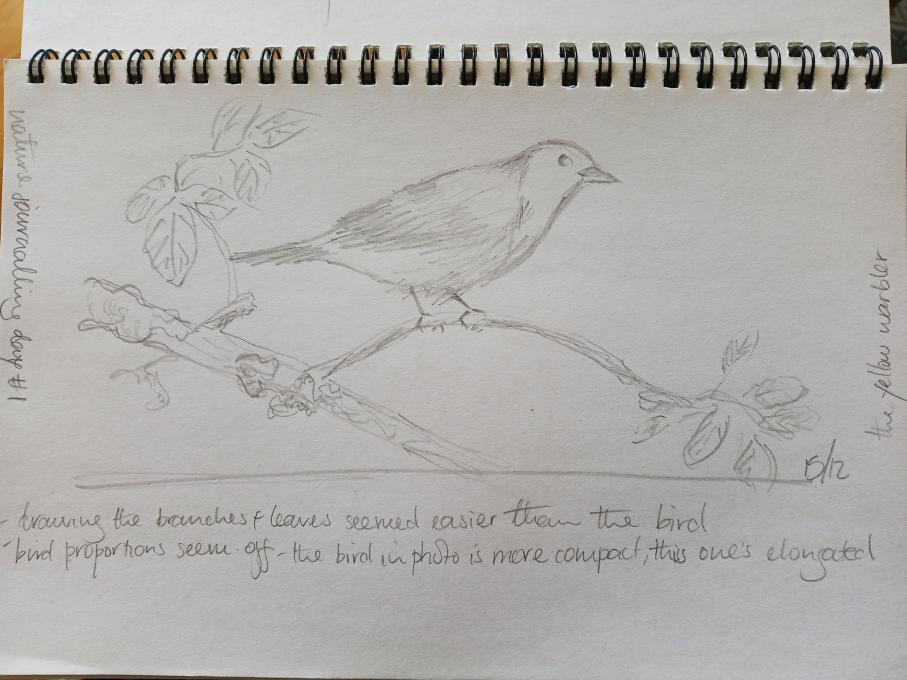 - drawing the branches and leaves seemed easier than drawing the warbler
- the warbler's proportions seem off, elongated in my drawing while it seems more compact in the photo
- fun exercise, glad to start on this course!
- drawing the branches and leaves seemed easier than drawing the warbler
- the warbler's proportions seem off, elongated in my drawing while it seems more compact in the photo
- fun exercise, glad to start on this course!
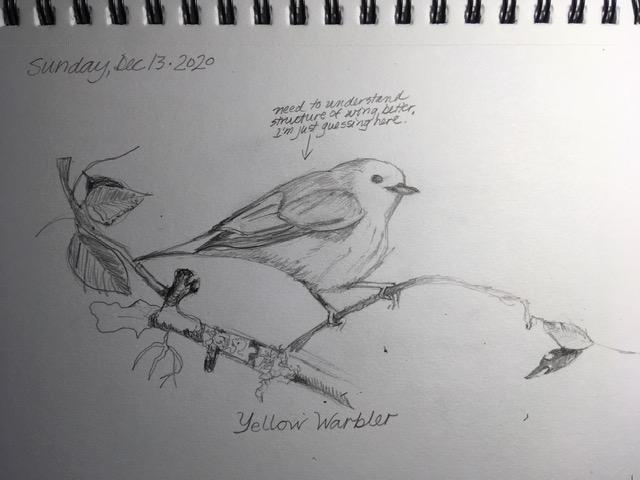 Drawing at all is a challenge after not doing it in so long. Drawing from the photo was helpful because, of course, the bird is not moving, in contrast to the birds at my feeder, who dart in and out, especially the nuthatches, or the birds in the woods, who are seldom close or still. The photo made it possible to really look carefully. I can see the different parts of the wings, but I really don't know how they all fit together. This helps me identify the knowledge I need. I think if I understand and draw the structure of the wing, that will help drawing in the field -- even quick sketches. I actually loved drawing the leaves and the lichen. My frequent "interactions" with leaves and lichens probably inform my drawing.
Drawing at all is a challenge after not doing it in so long. Drawing from the photo was helpful because, of course, the bird is not moving, in contrast to the birds at my feeder, who dart in and out, especially the nuthatches, or the birds in the woods, who are seldom close or still. The photo made it possible to really look carefully. I can see the different parts of the wings, but I really don't know how they all fit together. This helps me identify the knowledge I need. I think if I understand and draw the structure of the wing, that will help drawing in the field -- even quick sketches. I actually loved drawing the leaves and the lichen. My frequent "interactions" with leaves and lichens probably inform my drawing. 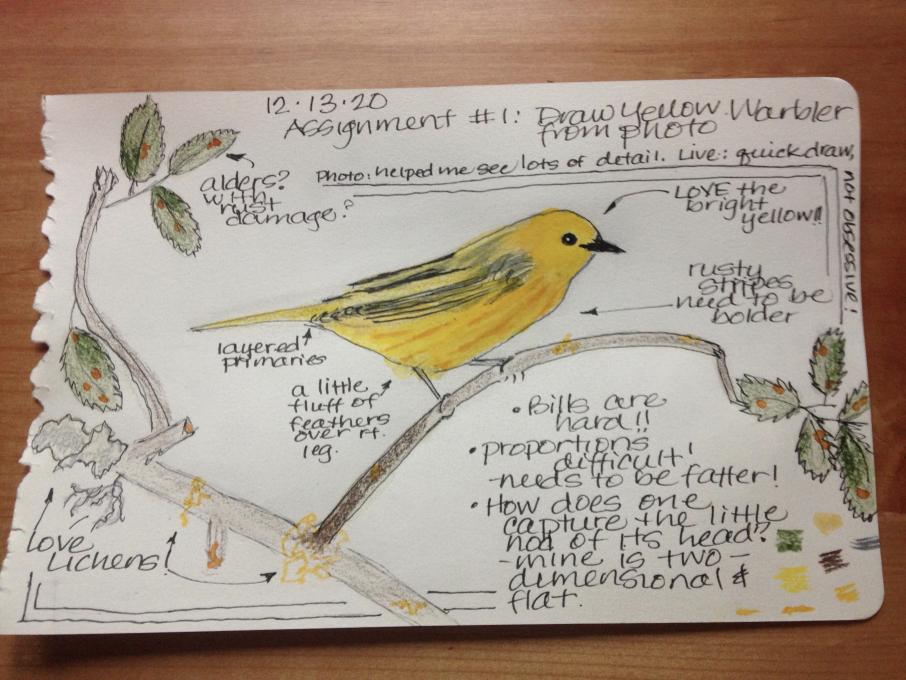
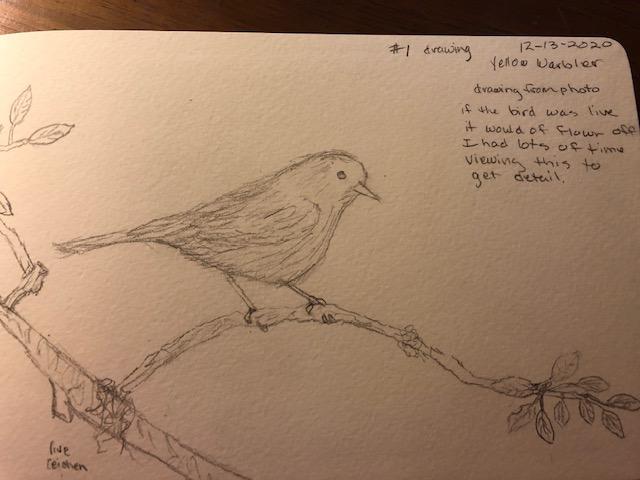
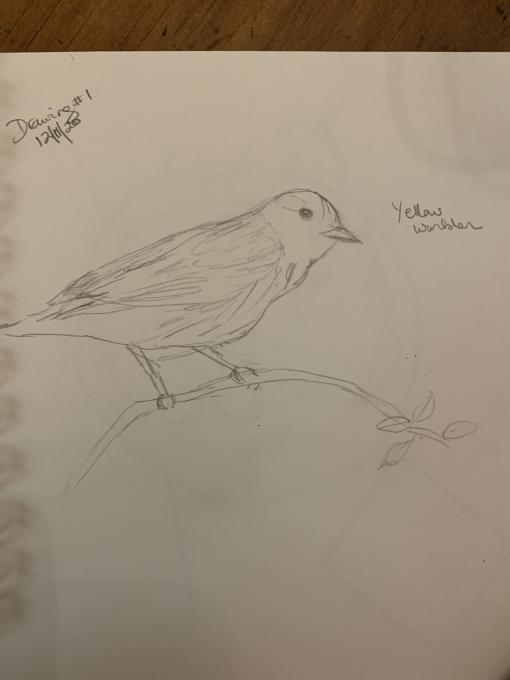
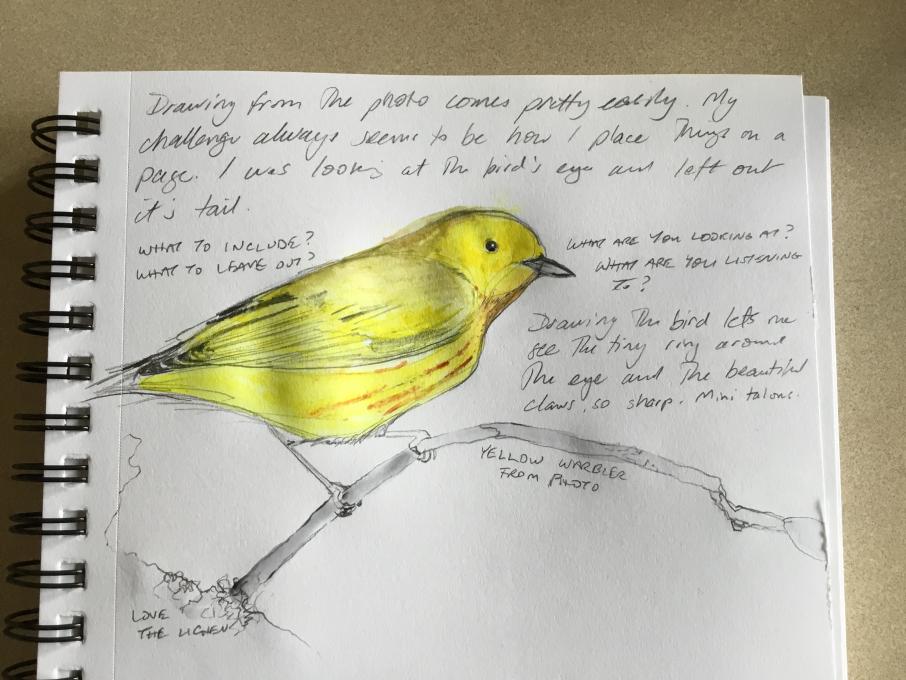
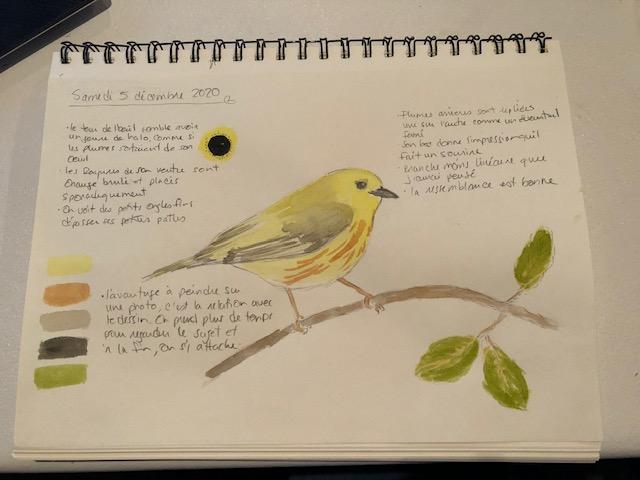
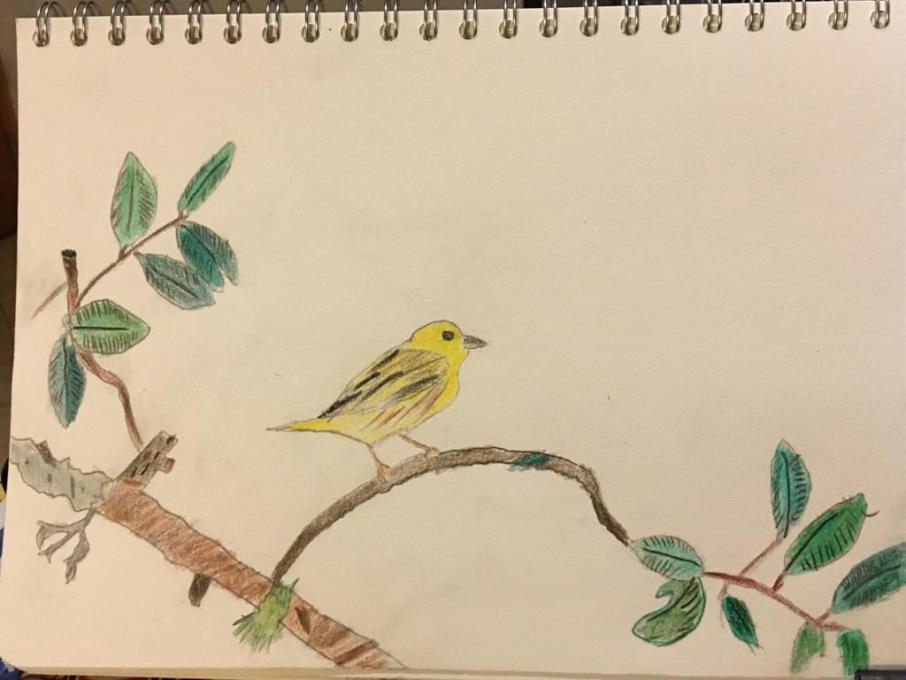 1. Very good, it was very good to jump directly to illustrate, I wanted to do it in a more detailed way similarly, detailing from the branches to the bird itself.
2.Maybe you see the details of the moss on the branches. This could make a difference because it could give us data on the type of vegetation and even the climate, in this case, for example, the moss on the branches denotes that it was a humid environment.
1. Very good, it was very good to jump directly to illustrate, I wanted to do it in a more detailed way similarly, detailing from the branches to the bird itself.
2.Maybe you see the details of the moss on the branches. This could make a difference because it could give us data on the type of vegetation and even the climate, in this case, for example, the moss on the branches denotes that it was a humid environment. 